Financial Decision Making and Business Performance Analysis
VerifiedAdded on 2020/01/28
|16
|4767
|56
Report
AI Summary
This report provides a comprehensive financial analysis of Elton PLC, a manufacturer of computer hardware and accessories. It begins with an executive summary and proceeds to analyze the company's business performance using financial statements, including the statement of profit or loss, statement of financial position, and statement of cash flows. The analysis incorporates various financial ratios, such as profitability, liquidity, and efficiency ratios, to assess the company's performance over time. The report also delves into investment appraisal techniques to evaluate the viability of business expansion. It examines non-monetary factors and potential sources of finance for expansion. The analysis concludes that business expansion in certain markets may not yield high financial benefits. The report includes tables summarizing key financial data and ratios, providing a clear overview of Elton PLC's financial health and strategic decision-making processes. The report also highlights the limitations of financial statements and provides a revised ratio analysis.

Financial decision making
1
1
Paraphrase This Document
Need a fresh take? Get an instant paraphrase of this document with our AI Paraphraser
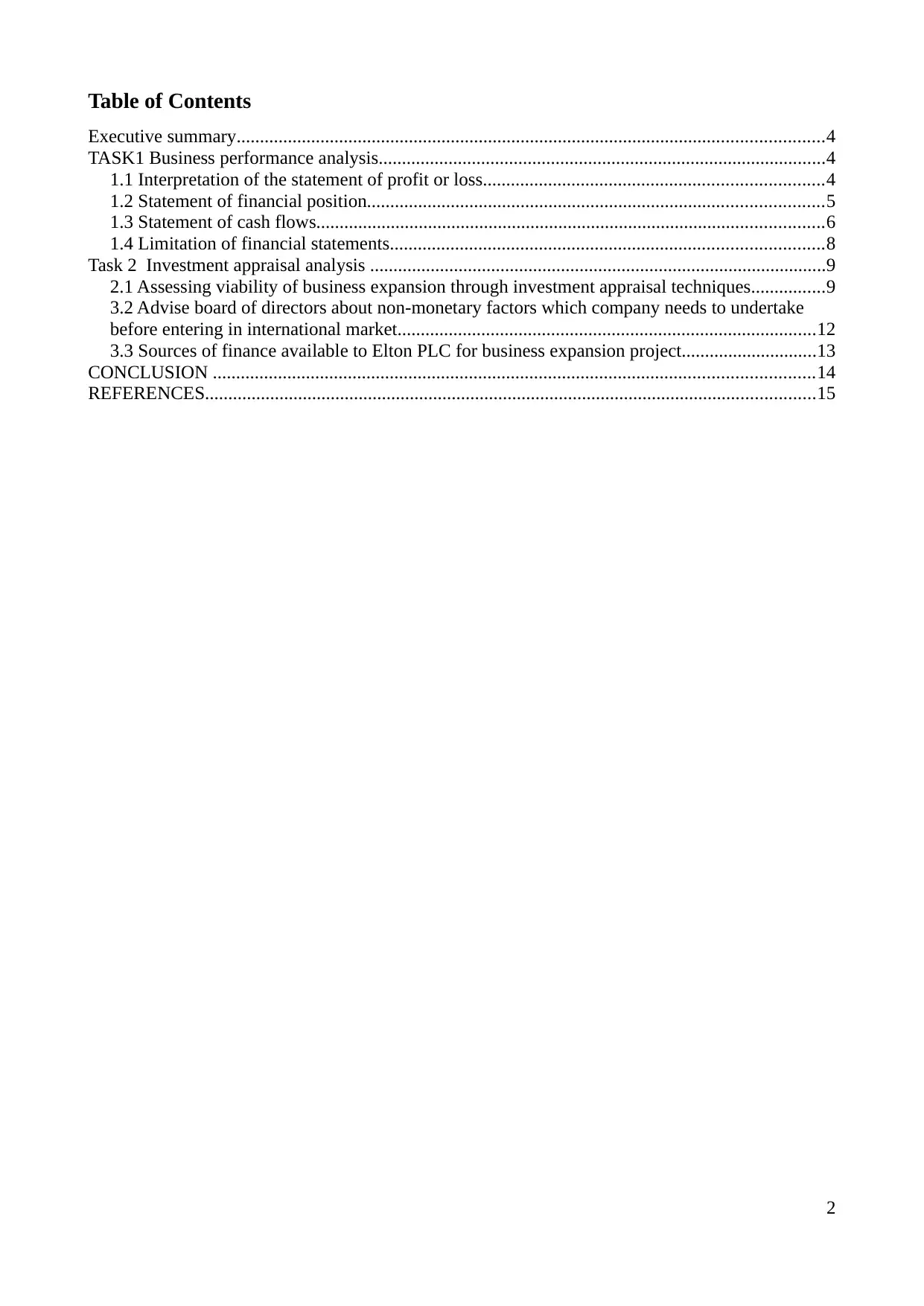
Table of Contents
Executive summary..............................................................................................................................4
TASK1 Business performance analysis................................................................................................4
1.1 Interpretation of the statement of profit or loss.........................................................................4
1.2 Statement of financial position..................................................................................................5
1.3 Statement of cash flows.............................................................................................................6
1.4 Limitation of financial statements.............................................................................................8
Task 2 Investment appraisal analysis ..................................................................................................9
2.1 Assessing viability of business expansion through investment appraisal techniques................9
3.2 Advise board of directors about non-monetary factors which company needs to undertake
before entering in international market..........................................................................................12
3.3 Sources of finance available to Elton PLC for business expansion project.............................13
CONCLUSION .................................................................................................................................14
REFERENCES...................................................................................................................................15
2
Executive summary..............................................................................................................................4
TASK1 Business performance analysis................................................................................................4
1.1 Interpretation of the statement of profit or loss.........................................................................4
1.2 Statement of financial position..................................................................................................5
1.3 Statement of cash flows.............................................................................................................6
1.4 Limitation of financial statements.............................................................................................8
Task 2 Investment appraisal analysis ..................................................................................................9
2.1 Assessing viability of business expansion through investment appraisal techniques................9
3.2 Advise board of directors about non-monetary factors which company needs to undertake
before entering in international market..........................................................................................12
3.3 Sources of finance available to Elton PLC for business expansion project.............................13
CONCLUSION .................................................................................................................................14
REFERENCES...................................................................................................................................15
2

Index of Tables
Table 1: Profitability ratios...................................................................................................................5
Table 2: Liquidity ratios.......................................................................................................................6
Table 3: Solvency and efficiency ratio.................................................................................................6
Table 4: Revised ratio analysis.............................................................................................................9
Table 5: Investment appraisal techniques...........................................................................................11
3
Table 1: Profitability ratios...................................................................................................................5
Table 2: Liquidity ratios.......................................................................................................................6
Table 3: Solvency and efficiency ratio.................................................................................................6
Table 4: Revised ratio analysis.............................................................................................................9
Table 5: Investment appraisal techniques...........................................................................................11
3
⊘ This is a preview!⊘
Do you want full access?
Subscribe today to unlock all pages.

Trusted by 1+ million students worldwide
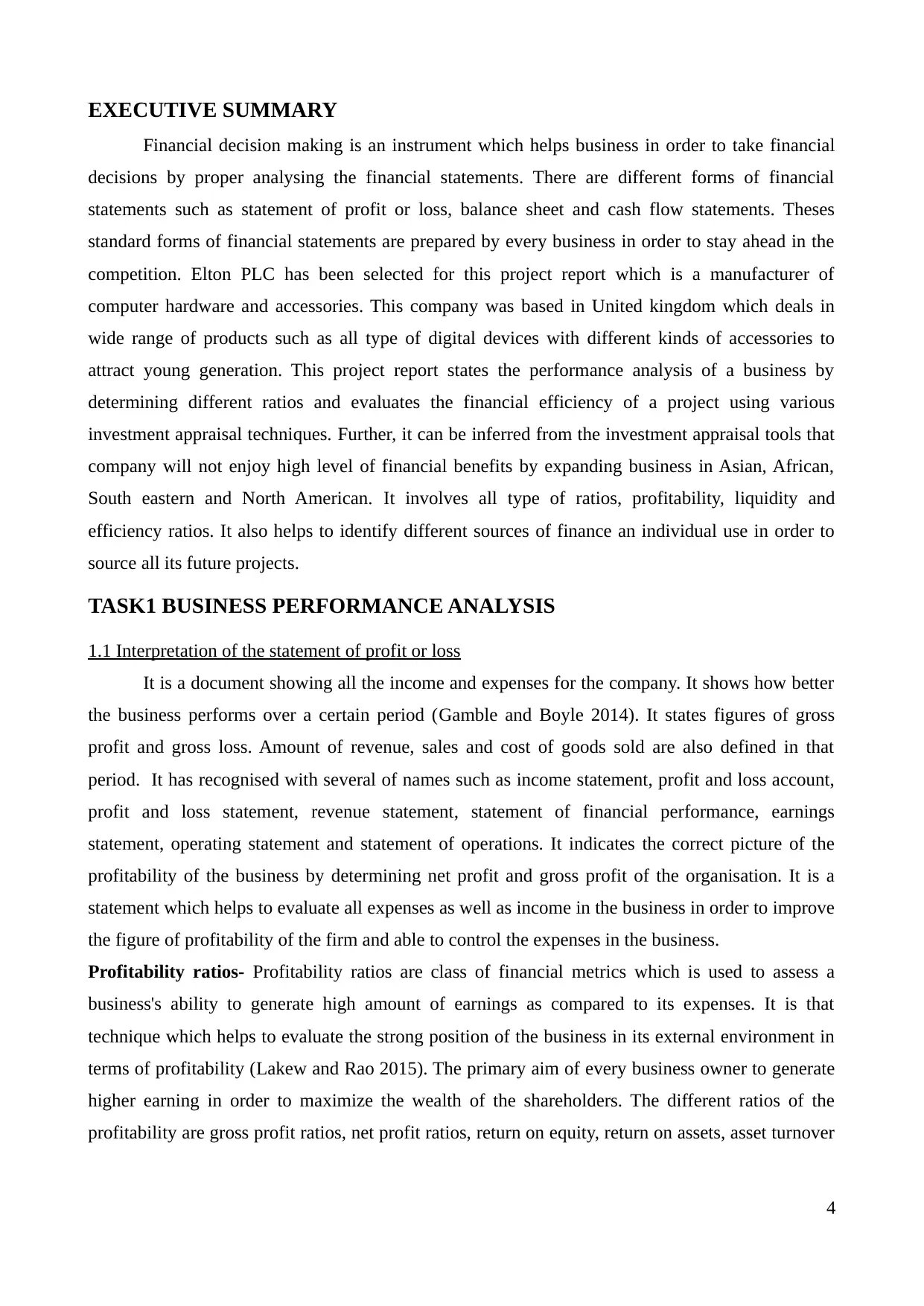
EXECUTIVE SUMMARY
Financial decision making is an instrument which helps business in order to take financial
decisions by proper analysing the financial statements. There are different forms of financial
statements such as statement of profit or loss, balance sheet and cash flow statements. Theses
standard forms of financial statements are prepared by every business in order to stay ahead in the
competition. Elton PLC has been selected for this project report which is a manufacturer of
computer hardware and accessories. This company was based in United kingdom which deals in
wide range of products such as all type of digital devices with different kinds of accessories to
attract young generation. This project report states the performance analysis of a business by
determining different ratios and evaluates the financial efficiency of a project using various
investment appraisal techniques. Further, it can be inferred from the investment appraisal tools that
company will not enjoy high level of financial benefits by expanding business in Asian, African,
South eastern and North American. It involves all type of ratios, profitability, liquidity and
efficiency ratios. It also helps to identify different sources of finance an individual use in order to
source all its future projects.
TASK1 BUSINESS PERFORMANCE ANALYSIS
1.1 Interpretation of the statement of profit or loss
It is a document showing all the income and expenses for the company. It shows how better
the business performs over a certain period (Gamble and Boyle 2014). It states figures of gross
profit and gross loss. Amount of revenue, sales and cost of goods sold are also defined in that
period. It has recognised with several of names such as income statement, profit and loss account,
profit and loss statement, revenue statement, statement of financial performance, earnings
statement, operating statement and statement of operations. It indicates the correct picture of the
profitability of the business by determining net profit and gross profit of the organisation. It is a
statement which helps to evaluate all expenses as well as income in the business in order to improve
the figure of profitability of the firm and able to control the expenses in the business.
Profitability ratios- Profitability ratios are class of financial metrics which is used to assess a
business's ability to generate high amount of earnings as compared to its expenses. It is that
technique which helps to evaluate the strong position of the business in its external environment in
terms of profitability (Lakew and Rao 2015). The primary aim of every business owner to generate
higher earning in order to maximize the wealth of the shareholders. The different ratios of the
profitability are gross profit ratios, net profit ratios, return on equity, return on assets, asset turnover
4
Financial decision making is an instrument which helps business in order to take financial
decisions by proper analysing the financial statements. There are different forms of financial
statements such as statement of profit or loss, balance sheet and cash flow statements. Theses
standard forms of financial statements are prepared by every business in order to stay ahead in the
competition. Elton PLC has been selected for this project report which is a manufacturer of
computer hardware and accessories. This company was based in United kingdom which deals in
wide range of products such as all type of digital devices with different kinds of accessories to
attract young generation. This project report states the performance analysis of a business by
determining different ratios and evaluates the financial efficiency of a project using various
investment appraisal techniques. Further, it can be inferred from the investment appraisal tools that
company will not enjoy high level of financial benefits by expanding business in Asian, African,
South eastern and North American. It involves all type of ratios, profitability, liquidity and
efficiency ratios. It also helps to identify different sources of finance an individual use in order to
source all its future projects.
TASK1 BUSINESS PERFORMANCE ANALYSIS
1.1 Interpretation of the statement of profit or loss
It is a document showing all the income and expenses for the company. It shows how better
the business performs over a certain period (Gamble and Boyle 2014). It states figures of gross
profit and gross loss. Amount of revenue, sales and cost of goods sold are also defined in that
period. It has recognised with several of names such as income statement, profit and loss account,
profit and loss statement, revenue statement, statement of financial performance, earnings
statement, operating statement and statement of operations. It indicates the correct picture of the
profitability of the business by determining net profit and gross profit of the organisation. It is a
statement which helps to evaluate all expenses as well as income in the business in order to improve
the figure of profitability of the firm and able to control the expenses in the business.
Profitability ratios- Profitability ratios are class of financial metrics which is used to assess a
business's ability to generate high amount of earnings as compared to its expenses. It is that
technique which helps to evaluate the strong position of the business in its external environment in
terms of profitability (Lakew and Rao 2015). The primary aim of every business owner to generate
higher earning in order to maximize the wealth of the shareholders. The different ratios of the
profitability are gross profit ratios, net profit ratios, return on equity, return on assets, asset turnover
4
Paraphrase This Document
Need a fresh take? Get an instant paraphrase of this document with our AI Paraphraser
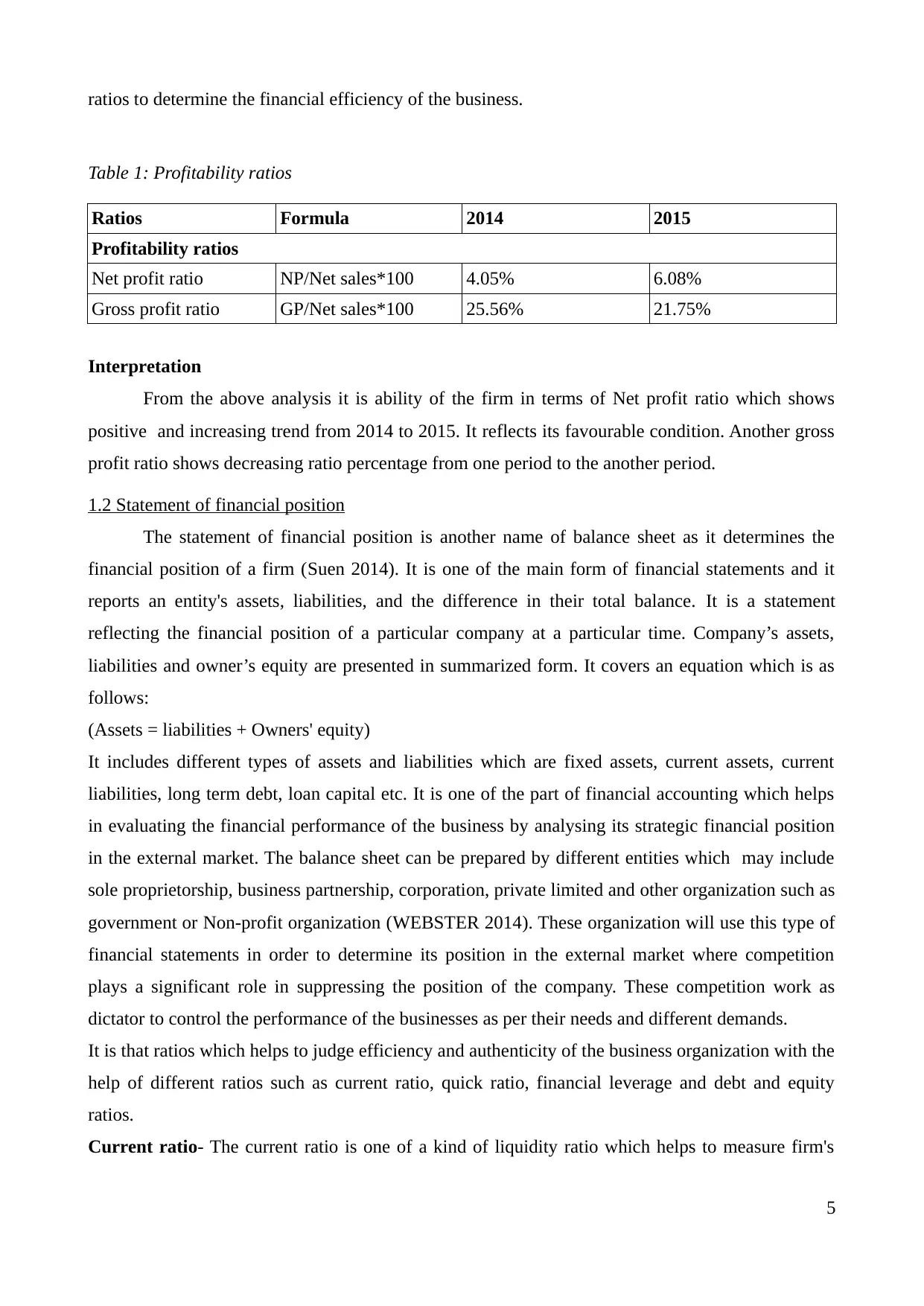
ratios to determine the financial efficiency of the business.
Table 1: Profitability ratios
Ratios Formula 2014 2015
Profitability ratios
Net profit ratio NP/Net sales*100 4.05% 6.08%
Gross profit ratio GP/Net sales*100 25.56% 21.75%
Interpretation
From the above analysis it is ability of the firm in terms of Net profit ratio which shows
positive and increasing trend from 2014 to 2015. It reflects its favourable condition. Another gross
profit ratio shows decreasing ratio percentage from one period to the another period.
1.2 Statement of financial position
The statement of financial position is another name of balance sheet as it determines the
financial position of a firm (Suen 2014). It is one of the main form of financial statements and it
reports an entity's assets, liabilities, and the difference in their total balance. It is a statement
reflecting the financial position of a particular company at a particular time. Company’s assets,
liabilities and owner’s equity are presented in summarized form. It covers an equation which is as
follows:
(Assets = liabilities + Owners' equity)
It includes different types of assets and liabilities which are fixed assets, current assets, current
liabilities, long term debt, loan capital etc. It is one of the part of financial accounting which helps
in evaluating the financial performance of the business by analysing its strategic financial position
in the external market. The balance sheet can be prepared by different entities which may include
sole proprietorship, business partnership, corporation, private limited and other organization such as
government or Non-profit organization (WEBSTER 2014). These organization will use this type of
financial statements in order to determine its position in the external market where competition
plays a significant role in suppressing the position of the company. These competition work as
dictator to control the performance of the businesses as per their needs and different demands.
It is that ratios which helps to judge efficiency and authenticity of the business organization with the
help of different ratios such as current ratio, quick ratio, financial leverage and debt and equity
ratios.
Current ratio- The current ratio is one of a kind of liquidity ratio which helps to measure firm's
5
Table 1: Profitability ratios
Ratios Formula 2014 2015
Profitability ratios
Net profit ratio NP/Net sales*100 4.05% 6.08%
Gross profit ratio GP/Net sales*100 25.56% 21.75%
Interpretation
From the above analysis it is ability of the firm in terms of Net profit ratio which shows
positive and increasing trend from 2014 to 2015. It reflects its favourable condition. Another gross
profit ratio shows decreasing ratio percentage from one period to the another period.
1.2 Statement of financial position
The statement of financial position is another name of balance sheet as it determines the
financial position of a firm (Suen 2014). It is one of the main form of financial statements and it
reports an entity's assets, liabilities, and the difference in their total balance. It is a statement
reflecting the financial position of a particular company at a particular time. Company’s assets,
liabilities and owner’s equity are presented in summarized form. It covers an equation which is as
follows:
(Assets = liabilities + Owners' equity)
It includes different types of assets and liabilities which are fixed assets, current assets, current
liabilities, long term debt, loan capital etc. It is one of the part of financial accounting which helps
in evaluating the financial performance of the business by analysing its strategic financial position
in the external market. The balance sheet can be prepared by different entities which may include
sole proprietorship, business partnership, corporation, private limited and other organization such as
government or Non-profit organization (WEBSTER 2014). These organization will use this type of
financial statements in order to determine its position in the external market where competition
plays a significant role in suppressing the position of the company. These competition work as
dictator to control the performance of the businesses as per their needs and different demands.
It is that ratios which helps to judge efficiency and authenticity of the business organization with the
help of different ratios such as current ratio, quick ratio, financial leverage and debt and equity
ratios.
Current ratio- The current ratio is one of a kind of liquidity ratio which helps to measure firm's
5
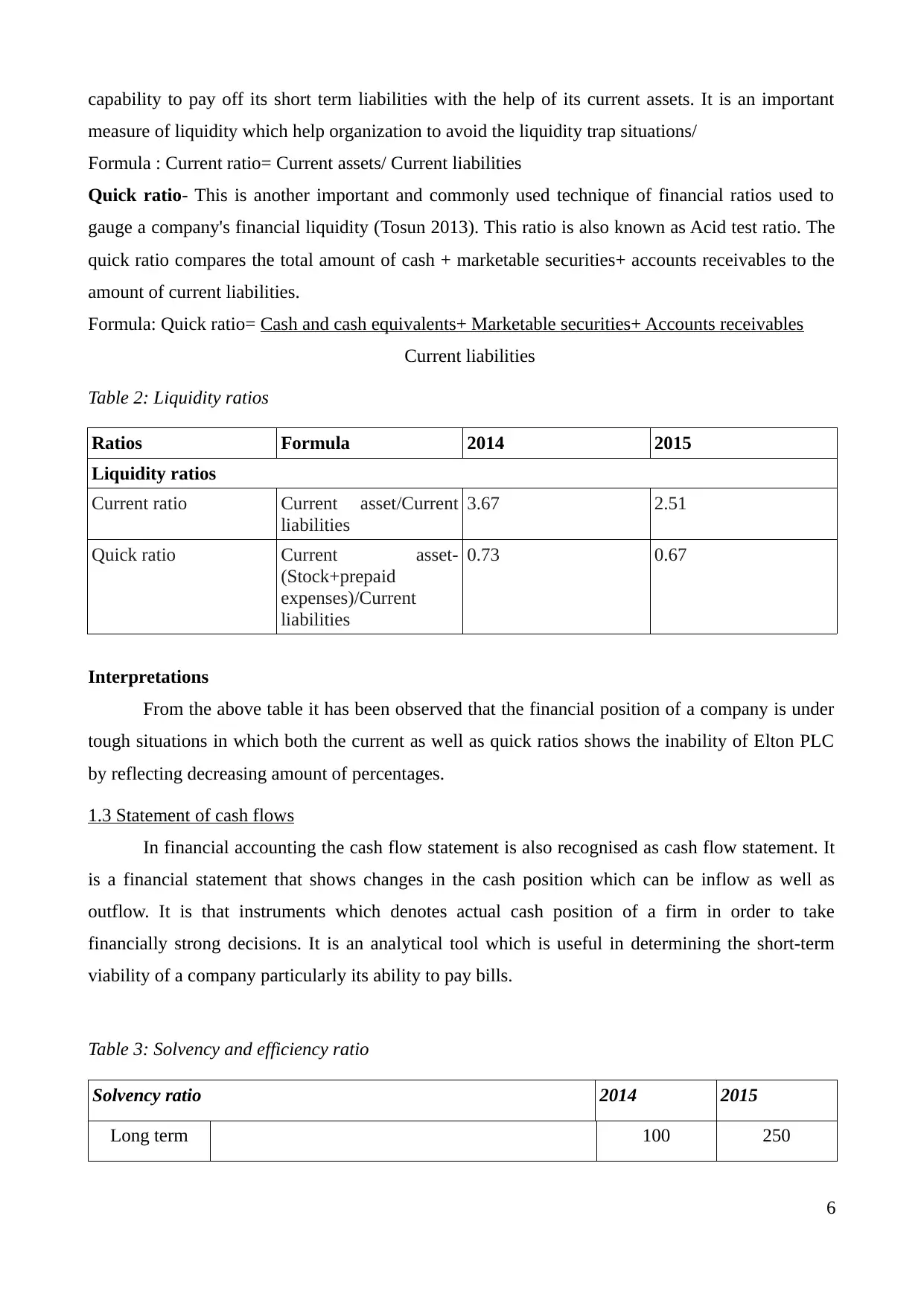
capability to pay off its short term liabilities with the help of its current assets. It is an important
measure of liquidity which help organization to avoid the liquidity trap situations/
Formula : Current ratio= Current assets/ Current liabilities
Quick ratio- This is another important and commonly used technique of financial ratios used to
gauge a company's financial liquidity (Tosun 2013). This ratio is also known as Acid test ratio. The
quick ratio compares the total amount of cash + marketable securities+ accounts receivables to the
amount of current liabilities.
Formula: Quick ratio= Cash and cash equivalents+ Marketable securities+ Accounts receivables
Current liabilities
Table 2: Liquidity ratios
Ratios Formula 2014 2015
Liquidity ratios
Current ratio Current asset/Current
liabilities
3.67 2.51
Quick ratio Current asset-
(Stock+prepaid
expenses)/Current
liabilities
0.73 0.67
Interpretations
From the above table it has been observed that the financial position of a company is under
tough situations in which both the current as well as quick ratios shows the inability of Elton PLC
by reflecting decreasing amount of percentages.
1.3 Statement of cash flows
In financial accounting the cash flow statement is also recognised as cash flow statement. It
is a financial statement that shows changes in the cash position which can be inflow as well as
outflow. It is that instruments which denotes actual cash position of a firm in order to take
financially strong decisions. It is an analytical tool which is useful in determining the short-term
viability of a company particularly its ability to pay bills.
Table 3: Solvency and efficiency ratio
Solvency ratio 2014 2015
Long term 100 250
6
measure of liquidity which help organization to avoid the liquidity trap situations/
Formula : Current ratio= Current assets/ Current liabilities
Quick ratio- This is another important and commonly used technique of financial ratios used to
gauge a company's financial liquidity (Tosun 2013). This ratio is also known as Acid test ratio. The
quick ratio compares the total amount of cash + marketable securities+ accounts receivables to the
amount of current liabilities.
Formula: Quick ratio= Cash and cash equivalents+ Marketable securities+ Accounts receivables
Current liabilities
Table 2: Liquidity ratios
Ratios Formula 2014 2015
Liquidity ratios
Current ratio Current asset/Current
liabilities
3.67 2.51
Quick ratio Current asset-
(Stock+prepaid
expenses)/Current
liabilities
0.73 0.67
Interpretations
From the above table it has been observed that the financial position of a company is under
tough situations in which both the current as well as quick ratios shows the inability of Elton PLC
by reflecting decreasing amount of percentages.
1.3 Statement of cash flows
In financial accounting the cash flow statement is also recognised as cash flow statement. It
is a financial statement that shows changes in the cash position which can be inflow as well as
outflow. It is that instruments which denotes actual cash position of a firm in order to take
financially strong decisions. It is an analytical tool which is useful in determining the short-term
viability of a company particularly its ability to pay bills.
Table 3: Solvency and efficiency ratio
Solvency ratio 2014 2015
Long term 100 250
6
⊘ This is a preview!⊘
Do you want full access?
Subscribe today to unlock all pages.

Trusted by 1+ million students worldwide
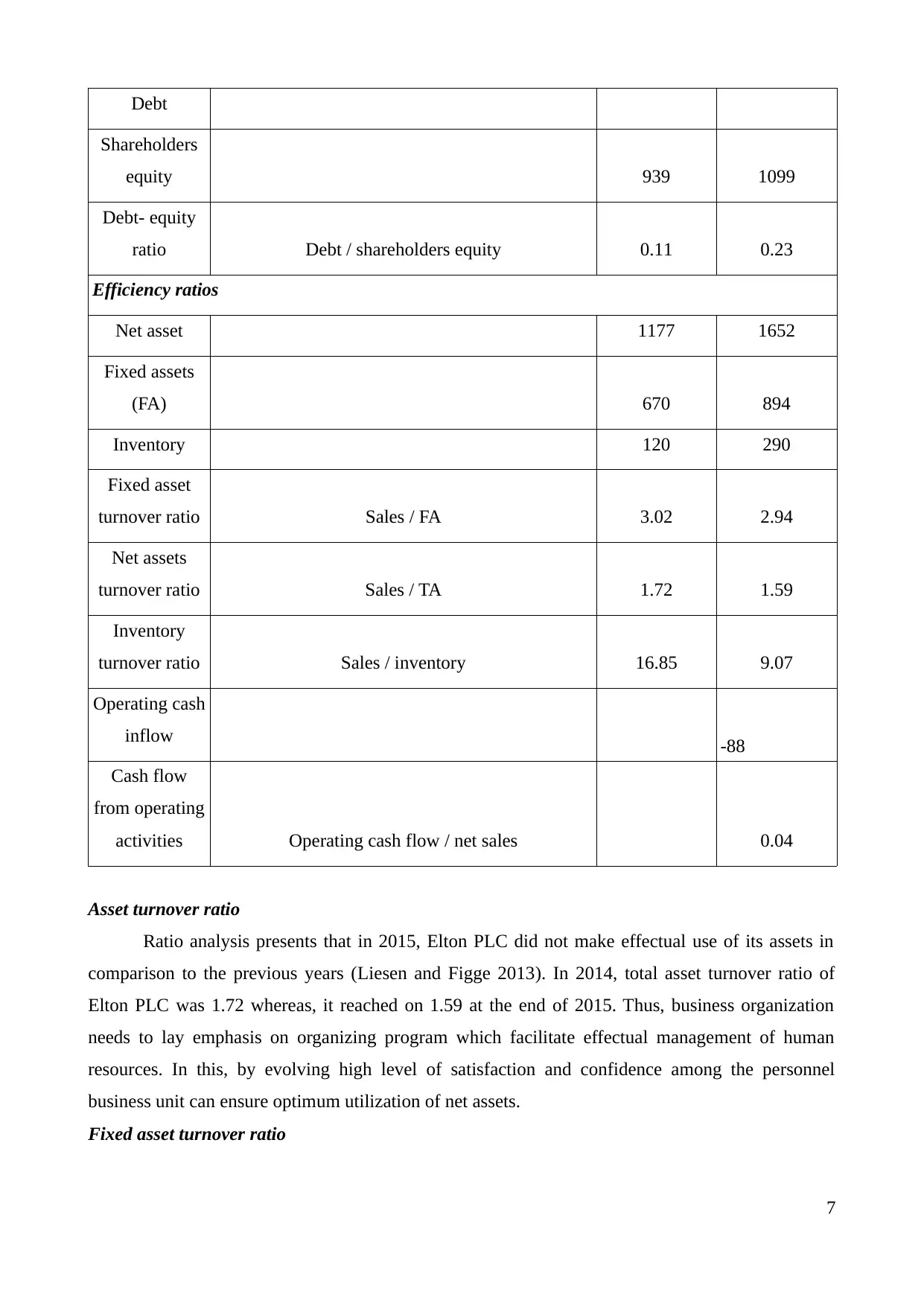
Debt
Shareholders
equity 939 1099
Debt- equity
ratio Debt / shareholders equity 0.11 0.23
Efficiency ratios
Net asset 1177 1652
Fixed assets
(FA) 670 894
Inventory 120 290
Fixed asset
turnover ratio Sales / FA 3.02 2.94
Net assets
turnover ratio Sales / TA 1.72 1.59
Inventory
turnover ratio Sales / inventory 16.85 9.07
Operating cash
inflow -88
Cash flow
from operating
activities Operating cash flow / net sales 0.04
Asset turnover ratio
Ratio analysis presents that in 2015, Elton PLC did not make effectual use of its assets in
comparison to the previous years (Liesen and Figge 2013). In 2014, total asset turnover ratio of
Elton PLC was 1.72 whereas, it reached on 1.59 at the end of 2015. Thus, business organization
needs to lay emphasis on organizing program which facilitate effectual management of human
resources. In this, by evolving high level of satisfaction and confidence among the personnel
business unit can ensure optimum utilization of net assets.
Fixed asset turnover ratio
7
Shareholders
equity 939 1099
Debt- equity
ratio Debt / shareholders equity 0.11 0.23
Efficiency ratios
Net asset 1177 1652
Fixed assets
(FA) 670 894
Inventory 120 290
Fixed asset
turnover ratio Sales / FA 3.02 2.94
Net assets
turnover ratio Sales / TA 1.72 1.59
Inventory
turnover ratio Sales / inventory 16.85 9.07
Operating cash
inflow -88
Cash flow
from operating
activities Operating cash flow / net sales 0.04
Asset turnover ratio
Ratio analysis presents that in 2015, Elton PLC did not make effectual use of its assets in
comparison to the previous years (Liesen and Figge 2013). In 2014, total asset turnover ratio of
Elton PLC was 1.72 whereas, it reached on 1.59 at the end of 2015. Thus, business organization
needs to lay emphasis on organizing program which facilitate effectual management of human
resources. In this, by evolving high level of satisfaction and confidence among the personnel
business unit can ensure optimum utilization of net assets.
Fixed asset turnover ratio
7
Paraphrase This Document
Need a fresh take? Get an instant paraphrase of this document with our AI Paraphraser
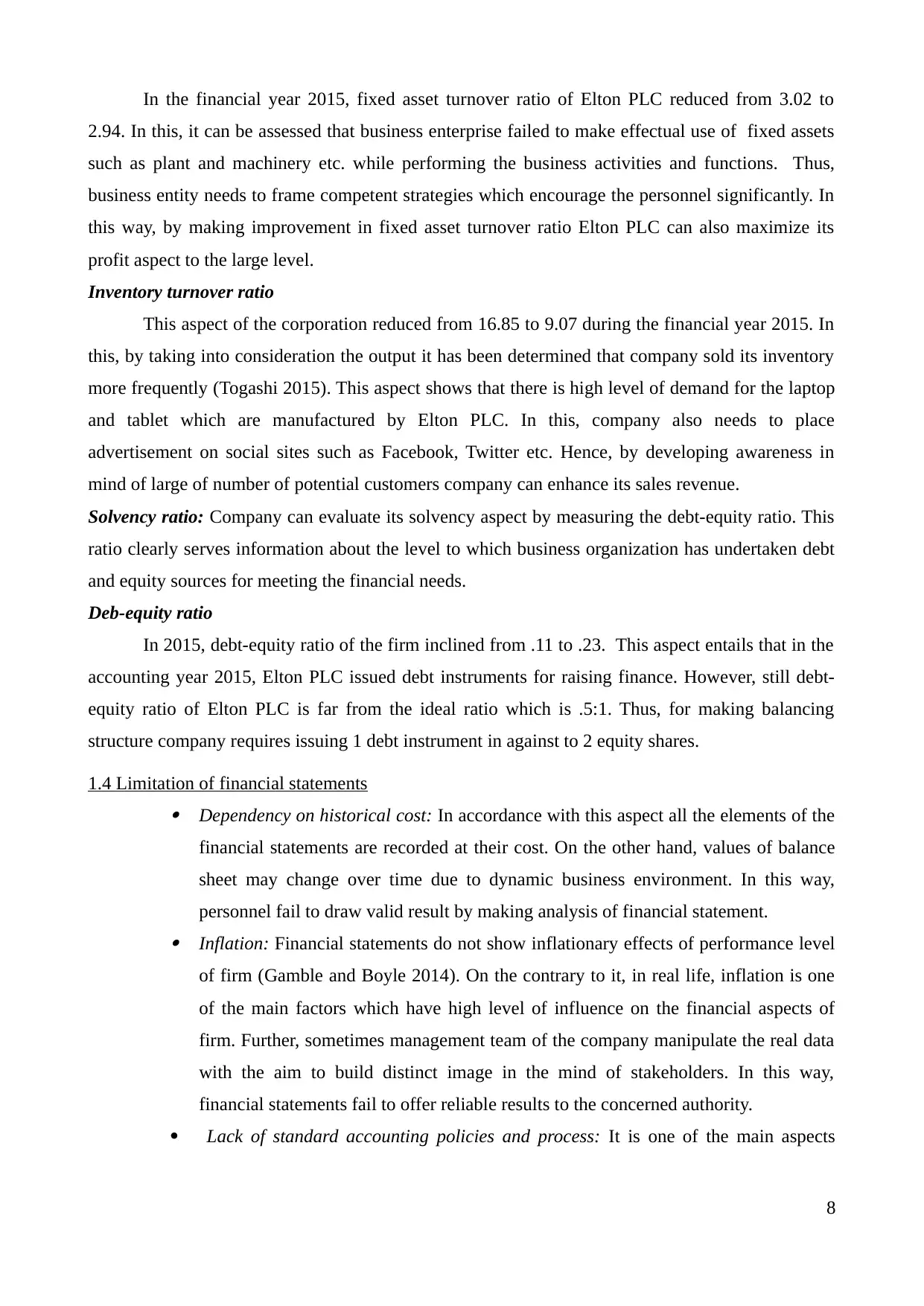
In the financial year 2015, fixed asset turnover ratio of Elton PLC reduced from 3.02 to
2.94. In this, it can be assessed that business enterprise failed to make effectual use of fixed assets
such as plant and machinery etc. while performing the business activities and functions. Thus,
business entity needs to frame competent strategies which encourage the personnel significantly. In
this way, by making improvement in fixed asset turnover ratio Elton PLC can also maximize its
profit aspect to the large level.
Inventory turnover ratio
This aspect of the corporation reduced from 16.85 to 9.07 during the financial year 2015. In
this, by taking into consideration the output it has been determined that company sold its inventory
more frequently (Togashi 2015). This aspect shows that there is high level of demand for the laptop
and tablet which are manufactured by Elton PLC. In this, company also needs to place
advertisement on social sites such as Facebook, Twitter etc. Hence, by developing awareness in
mind of large of number of potential customers company can enhance its sales revenue.
Solvency ratio: Company can evaluate its solvency aspect by measuring the debt-equity ratio. This
ratio clearly serves information about the level to which business organization has undertaken debt
and equity sources for meeting the financial needs.
Deb-equity ratio
In 2015, debt-equity ratio of the firm inclined from .11 to .23. This aspect entails that in the
accounting year 2015, Elton PLC issued debt instruments for raising finance. However, still debt-
equity ratio of Elton PLC is far from the ideal ratio which is .5:1. Thus, for making balancing
structure company requires issuing 1 debt instrument in against to 2 equity shares.
1.4 Limitation of financial statements
Dependency on historical cost: In accordance with this aspect all the elements of the
financial statements are recorded at their cost. On the other hand, values of balance
sheet may change over time due to dynamic business environment. In this way,
personnel fail to draw valid result by making analysis of financial statement.
Inflation: Financial statements do not show inflationary effects of performance level
of firm (Gamble and Boyle 2014). On the contrary to it, in real life, inflation is one
of the main factors which have high level of influence on the financial aspects of
firm. Further, sometimes management team of the company manipulate the real data
with the aim to build distinct image in the mind of stakeholders. In this way,
financial statements fail to offer reliable results to the concerned authority.
Lack of standard accounting policies and process: It is one of the main aspects
8
2.94. In this, it can be assessed that business enterprise failed to make effectual use of fixed assets
such as plant and machinery etc. while performing the business activities and functions. Thus,
business entity needs to frame competent strategies which encourage the personnel significantly. In
this way, by making improvement in fixed asset turnover ratio Elton PLC can also maximize its
profit aspect to the large level.
Inventory turnover ratio
This aspect of the corporation reduced from 16.85 to 9.07 during the financial year 2015. In
this, by taking into consideration the output it has been determined that company sold its inventory
more frequently (Togashi 2015). This aspect shows that there is high level of demand for the laptop
and tablet which are manufactured by Elton PLC. In this, company also needs to place
advertisement on social sites such as Facebook, Twitter etc. Hence, by developing awareness in
mind of large of number of potential customers company can enhance its sales revenue.
Solvency ratio: Company can evaluate its solvency aspect by measuring the debt-equity ratio. This
ratio clearly serves information about the level to which business organization has undertaken debt
and equity sources for meeting the financial needs.
Deb-equity ratio
In 2015, debt-equity ratio of the firm inclined from .11 to .23. This aspect entails that in the
accounting year 2015, Elton PLC issued debt instruments for raising finance. However, still debt-
equity ratio of Elton PLC is far from the ideal ratio which is .5:1. Thus, for making balancing
structure company requires issuing 1 debt instrument in against to 2 equity shares.
1.4 Limitation of financial statements
Dependency on historical cost: In accordance with this aspect all the elements of the
financial statements are recorded at their cost. On the other hand, values of balance
sheet may change over time due to dynamic business environment. In this way,
personnel fail to draw valid result by making analysis of financial statement.
Inflation: Financial statements do not show inflationary effects of performance level
of firm (Gamble and Boyle 2014). On the contrary to it, in real life, inflation is one
of the main factors which have high level of influence on the financial aspects of
firm. Further, sometimes management team of the company manipulate the real data
with the aim to build distinct image in the mind of stakeholders. In this way,
financial statements fail to offer reliable results to the concerned authority.
Lack of standard accounting policies and process: It is one of the main aspects
8
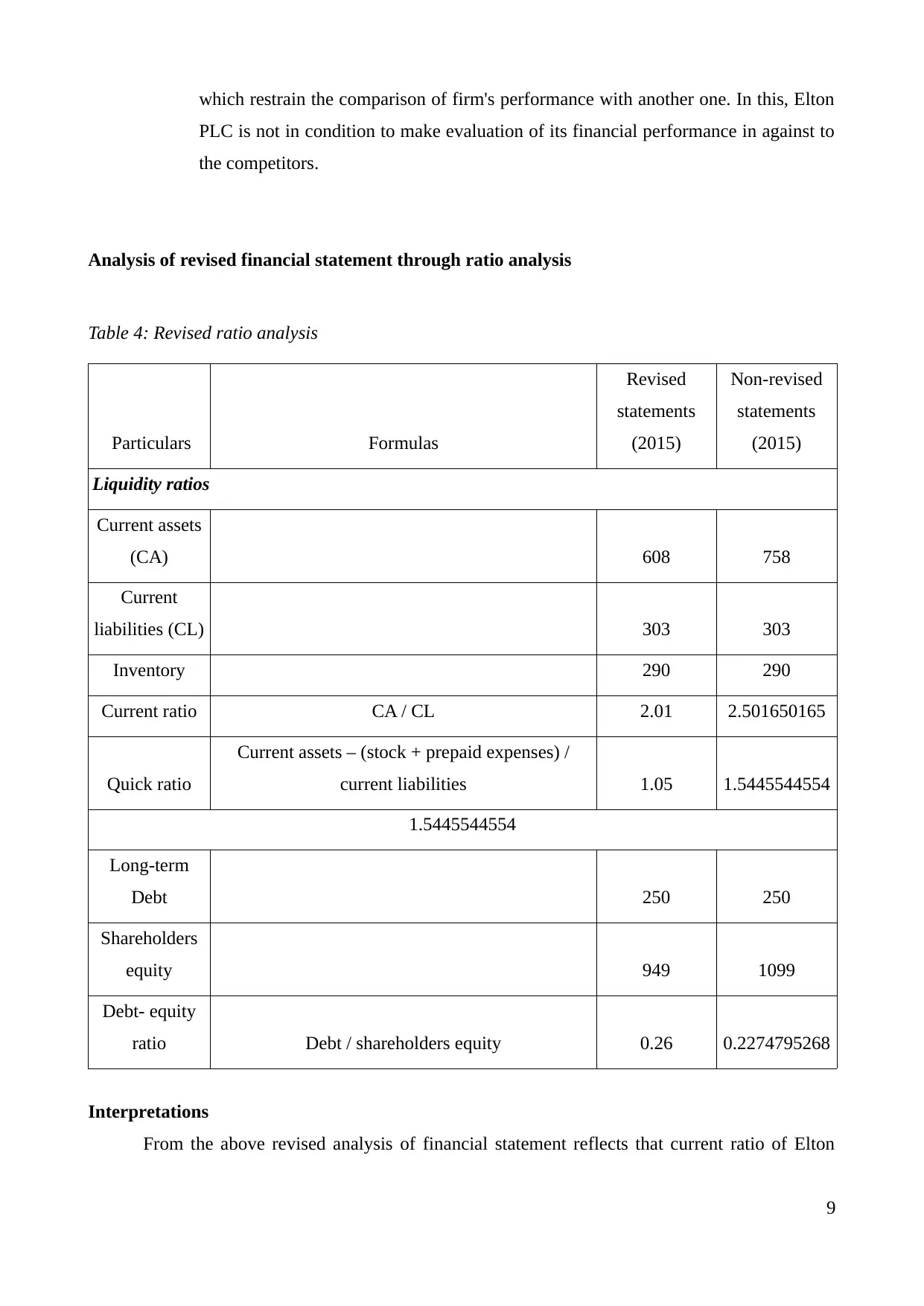
which restrain the comparison of firm's performance with another one. In this, Elton
PLC is not in condition to make evaluation of its financial performance in against to
the competitors.
Analysis of revised financial statement through ratio analysis
Table 4: Revised ratio analysis
Particulars Formulas
Revised
statements
(2015)
Non-revised
statements
(2015)
Liquidity ratios
Current assets
(CA) 608 758
Current
liabilities (CL) 303 303
Inventory 290 290
Current ratio CA / CL 2.01 2.501650165
Quick ratio
Current assets – (stock + prepaid expenses) /
current liabilities 1.05 1.5445544554
1.5445544554
Long-term
Debt 250 250
Shareholders
equity 949 1099
Debt- equity
ratio Debt / shareholders equity 0.26 0.2274795268
Interpretations
From the above revised analysis of financial statement reflects that current ratio of Elton
9
PLC is not in condition to make evaluation of its financial performance in against to
the competitors.
Analysis of revised financial statement through ratio analysis
Table 4: Revised ratio analysis
Particulars Formulas
Revised
statements
(2015)
Non-revised
statements
(2015)
Liquidity ratios
Current assets
(CA) 608 758
Current
liabilities (CL) 303 303
Inventory 290 290
Current ratio CA / CL 2.01 2.501650165
Quick ratio
Current assets – (stock + prepaid expenses) /
current liabilities 1.05 1.5445544554
1.5445544554
Long-term
Debt 250 250
Shareholders
equity 949 1099
Debt- equity
ratio Debt / shareholders equity 0.26 0.2274795268
Interpretations
From the above revised analysis of financial statement reflects that current ratio of Elton
9
⊘ This is a preview!⊘
Do you want full access?
Subscribe today to unlock all pages.

Trusted by 1+ million students worldwide
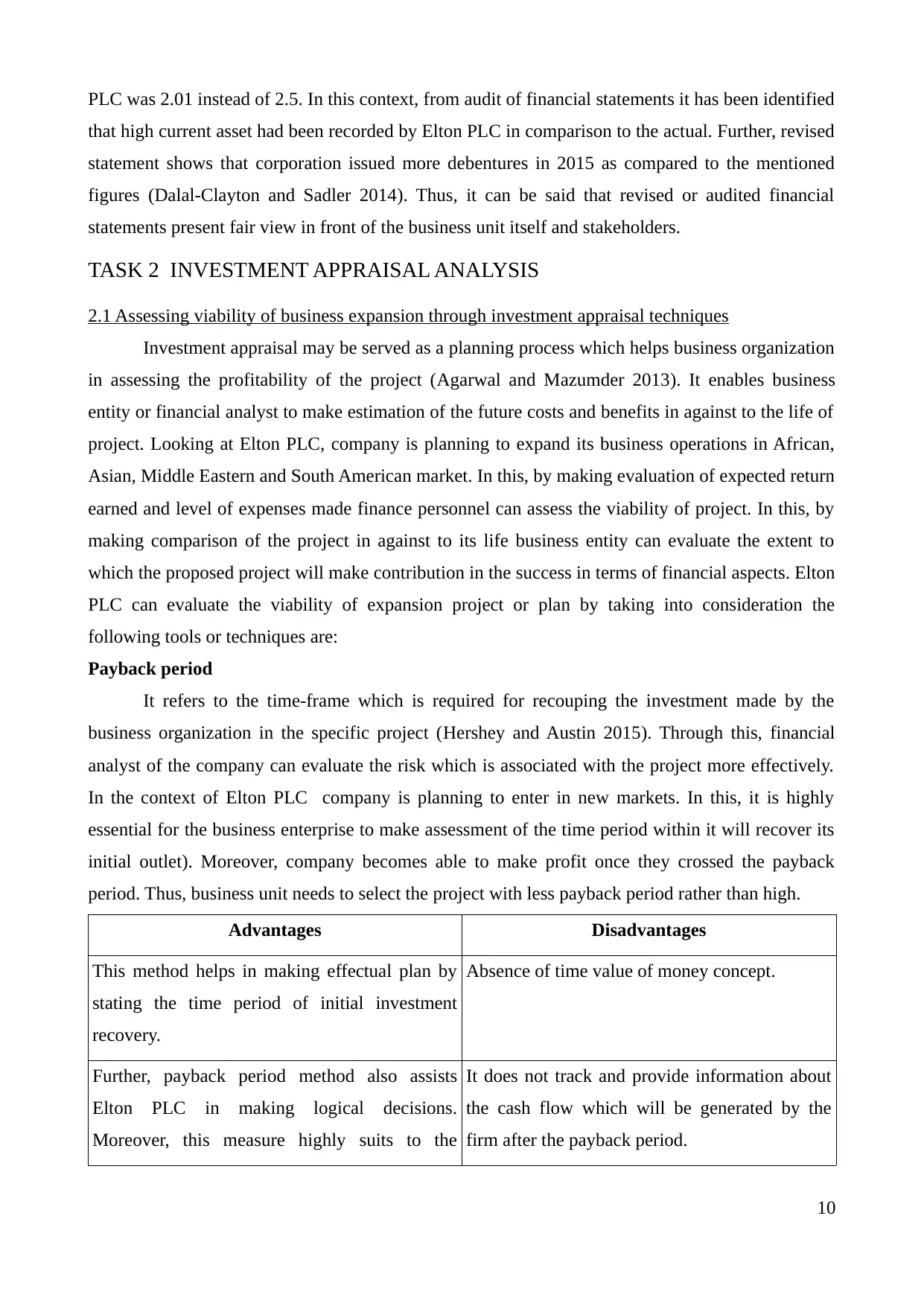
PLC was 2.01 instead of 2.5. In this context, from audit of financial statements it has been identified
that high current asset had been recorded by Elton PLC in comparison to the actual. Further, revised
statement shows that corporation issued more debentures in 2015 as compared to the mentioned
figures (Dalal-Clayton and Sadler 2014). Thus, it can be said that revised or audited financial
statements present fair view in front of the business unit itself and stakeholders.
TASK 2 INVESTMENT APPRAISAL ANALYSIS
2.1 Assessing viability of business expansion through investment appraisal techniques
Investment appraisal may be served as a planning process which helps business organization
in assessing the profitability of the project (Agarwal and Mazumder 2013). It enables business
entity or financial analyst to make estimation of the future costs and benefits in against to the life of
project. Looking at Elton PLC, company is planning to expand its business operations in African,
Asian, Middle Eastern and South American market. In this, by making evaluation of expected return
earned and level of expenses made finance personnel can assess the viability of project. In this, by
making comparison of the project in against to its life business entity can evaluate the extent to
which the proposed project will make contribution in the success in terms of financial aspects. Elton
PLC can evaluate the viability of expansion project or plan by taking into consideration the
following tools or techniques are:
Payback period
It refers to the time-frame which is required for recouping the investment made by the
business organization in the specific project (Hershey and Austin 2015). Through this, financial
analyst of the company can evaluate the risk which is associated with the project more effectively.
In the context of Elton PLC company is planning to enter in new markets. In this, it is highly
essential for the business enterprise to make assessment of the time period within it will recover its
initial outlet). Moreover, company becomes able to make profit once they crossed the payback
period. Thus, business unit needs to select the project with less payback period rather than high.
Advantages Disadvantages
This method helps in making effectual plan by
stating the time period of initial investment
recovery.
Absence of time value of money concept.
Further, payback period method also assists
Elton PLC in making logical decisions.
Moreover, this measure highly suits to the
It does not track and provide information about
the cash flow which will be generated by the
firm after the payback period.
10
that high current asset had been recorded by Elton PLC in comparison to the actual. Further, revised
statement shows that corporation issued more debentures in 2015 as compared to the mentioned
figures (Dalal-Clayton and Sadler 2014). Thus, it can be said that revised or audited financial
statements present fair view in front of the business unit itself and stakeholders.
TASK 2 INVESTMENT APPRAISAL ANALYSIS
2.1 Assessing viability of business expansion through investment appraisal techniques
Investment appraisal may be served as a planning process which helps business organization
in assessing the profitability of the project (Agarwal and Mazumder 2013). It enables business
entity or financial analyst to make estimation of the future costs and benefits in against to the life of
project. Looking at Elton PLC, company is planning to expand its business operations in African,
Asian, Middle Eastern and South American market. In this, by making evaluation of expected return
earned and level of expenses made finance personnel can assess the viability of project. In this, by
making comparison of the project in against to its life business entity can evaluate the extent to
which the proposed project will make contribution in the success in terms of financial aspects. Elton
PLC can evaluate the viability of expansion project or plan by taking into consideration the
following tools or techniques are:
Payback period
It refers to the time-frame which is required for recouping the investment made by the
business organization in the specific project (Hershey and Austin 2015). Through this, financial
analyst of the company can evaluate the risk which is associated with the project more effectively.
In the context of Elton PLC company is planning to enter in new markets. In this, it is highly
essential for the business enterprise to make assessment of the time period within it will recover its
initial outlet). Moreover, company becomes able to make profit once they crossed the payback
period. Thus, business unit needs to select the project with less payback period rather than high.
Advantages Disadvantages
This method helps in making effectual plan by
stating the time period of initial investment
recovery.
Absence of time value of money concept.
Further, payback period method also assists
Elton PLC in making logical decisions.
Moreover, this measure highly suits to the
It does not track and provide information about
the cash flow which will be generated by the
firm after the payback period.
10
Paraphrase This Document
Need a fresh take? Get an instant paraphrase of this document with our AI Paraphraser
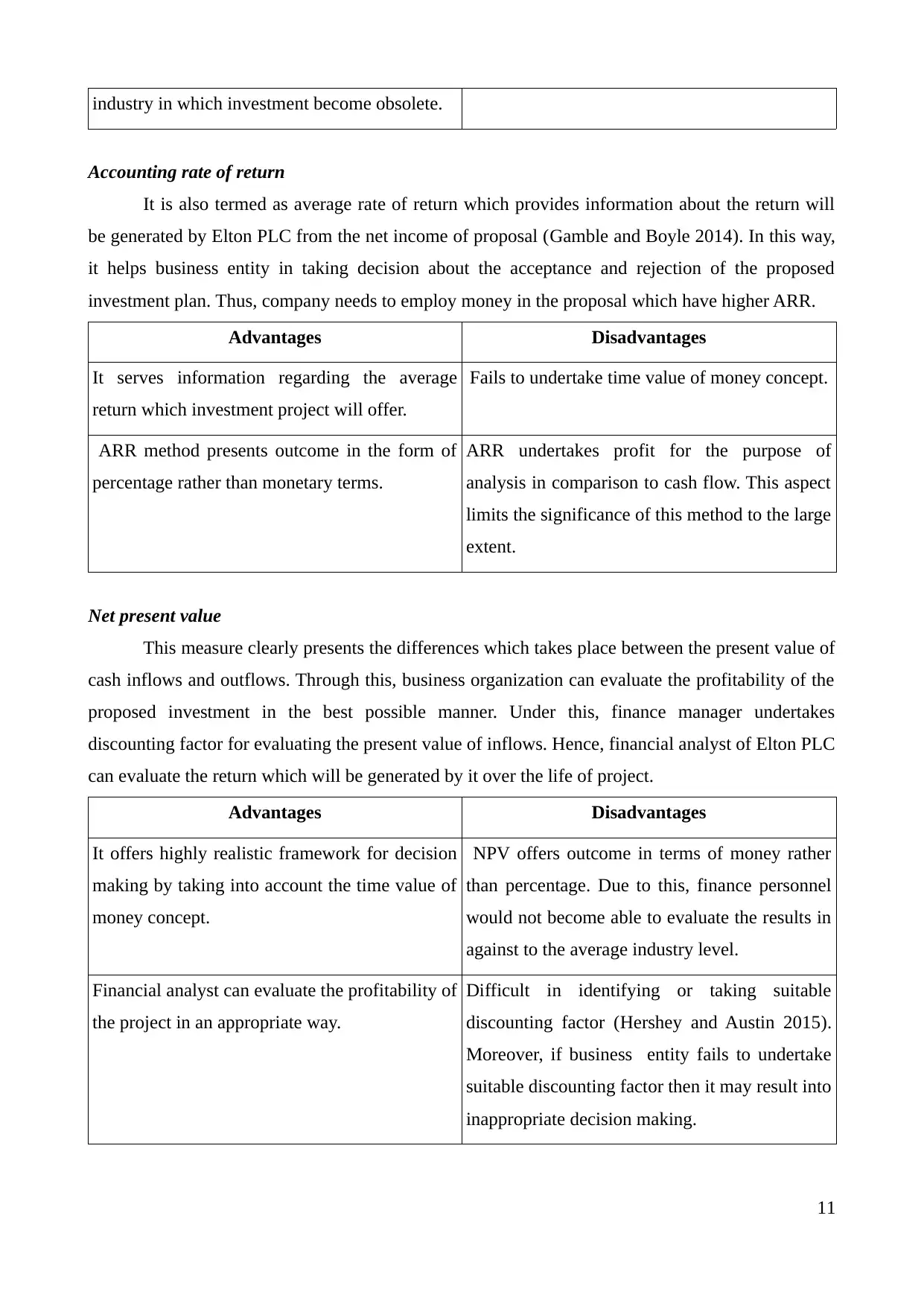
industry in which investment become obsolete.
Accounting rate of return
It is also termed as average rate of return which provides information about the return will
be generated by Elton PLC from the net income of proposal (Gamble and Boyle 2014). In this way,
it helps business entity in taking decision about the acceptance and rejection of the proposed
investment plan. Thus, company needs to employ money in the proposal which have higher ARR.
Advantages Disadvantages
It serves information regarding the average
return which investment project will offer.
Fails to undertake time value of money concept.
ARR method presents outcome in the form of
percentage rather than monetary terms.
ARR undertakes profit for the purpose of
analysis in comparison to cash flow. This aspect
limits the significance of this method to the large
extent.
Net present value
This measure clearly presents the differences which takes place between the present value of
cash inflows and outflows. Through this, business organization can evaluate the profitability of the
proposed investment in the best possible manner. Under this, finance manager undertakes
discounting factor for evaluating the present value of inflows. Hence, financial analyst of Elton PLC
can evaluate the return which will be generated by it over the life of project.
Advantages Disadvantages
It offers highly realistic framework for decision
making by taking into account the time value of
money concept.
NPV offers outcome in terms of money rather
than percentage. Due to this, finance personnel
would not become able to evaluate the results in
against to the average industry level.
Financial analyst can evaluate the profitability of
the project in an appropriate way.
Difficult in identifying or taking suitable
discounting factor (Hershey and Austin 2015).
Moreover, if business entity fails to undertake
suitable discounting factor then it may result into
inappropriate decision making.
11
Accounting rate of return
It is also termed as average rate of return which provides information about the return will
be generated by Elton PLC from the net income of proposal (Gamble and Boyle 2014). In this way,
it helps business entity in taking decision about the acceptance and rejection of the proposed
investment plan. Thus, company needs to employ money in the proposal which have higher ARR.
Advantages Disadvantages
It serves information regarding the average
return which investment project will offer.
Fails to undertake time value of money concept.
ARR method presents outcome in the form of
percentage rather than monetary terms.
ARR undertakes profit for the purpose of
analysis in comparison to cash flow. This aspect
limits the significance of this method to the large
extent.
Net present value
This measure clearly presents the differences which takes place between the present value of
cash inflows and outflows. Through this, business organization can evaluate the profitability of the
proposed investment in the best possible manner. Under this, finance manager undertakes
discounting factor for evaluating the present value of inflows. Hence, financial analyst of Elton PLC
can evaluate the return which will be generated by it over the life of project.
Advantages Disadvantages
It offers highly realistic framework for decision
making by taking into account the time value of
money concept.
NPV offers outcome in terms of money rather
than percentage. Due to this, finance personnel
would not become able to evaluate the results in
against to the average industry level.
Financial analyst can evaluate the profitability of
the project in an appropriate way.
Difficult in identifying or taking suitable
discounting factor (Hershey and Austin 2015).
Moreover, if business entity fails to undertake
suitable discounting factor then it may result into
inappropriate decision making.
11
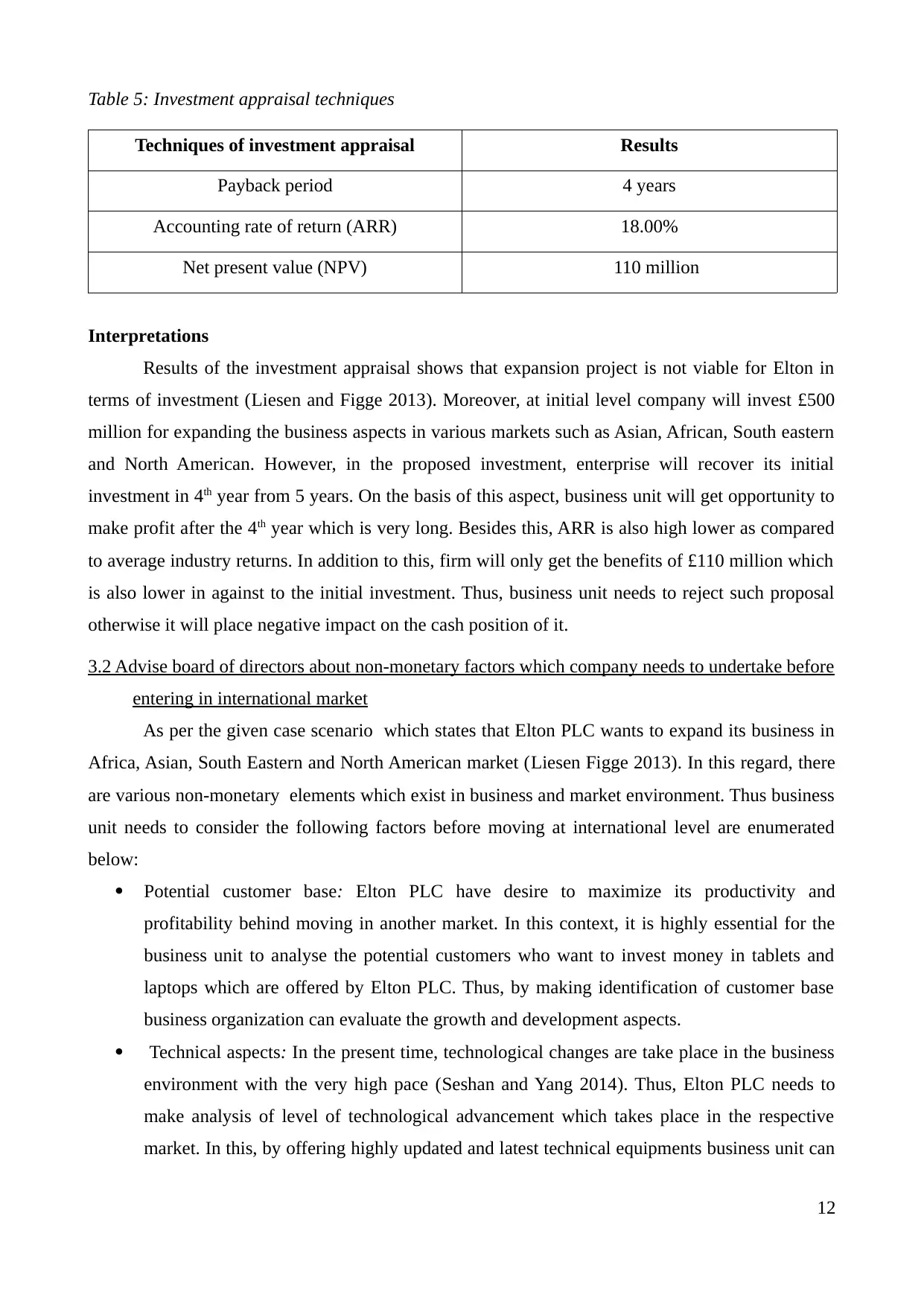
Table 5: Investment appraisal techniques
Techniques of investment appraisal Results
Payback period 4 years
Accounting rate of return (ARR) 18.00%
Net present value (NPV) £110 million
Interpretations
Results of the investment appraisal shows that expansion project is not viable for Elton in
terms of investment (Liesen and Figge 2013). Moreover, at initial level company will invest £500
million for expanding the business aspects in various markets such as Asian, African, South eastern
and North American. However, in the proposed investment, enterprise will recover its initial
investment in 4th year from 5 years. On the basis of this aspect, business unit will get opportunity to
make profit after the 4th year which is very long. Besides this, ARR is also high lower as compared
to average industry returns. In addition to this, firm will only get the benefits of £110 million which
is also lower in against to the initial investment. Thus, business unit needs to reject such proposal
otherwise it will place negative impact on the cash position of it.
3.2 Advise board of directors about non-monetary factors which company needs to undertake before
entering in international market
As per the given case scenario which states that Elton PLC wants to expand its business in
Africa, Asian, South Eastern and North American market (Liesen Figge 2013). In this regard, there
are various non-monetary elements which exist in business and market environment. Thus business
unit needs to consider the following factors before moving at international level are enumerated
below:
Potential customer base: Elton PLC have desire to maximize its productivity and
profitability behind moving in another market. In this context, it is highly essential for the
business unit to analyse the potential customers who want to invest money in tablets and
laptops which are offered by Elton PLC. Thus, by making identification of customer base
business organization can evaluate the growth and development aspects.
Technical aspects: In the present time, technological changes are take place in the business
environment with the very high pace (Seshan and Yang 2014). Thus, Elton PLC needs to
make analysis of level of technological advancement which takes place in the respective
market. In this, by offering highly updated and latest technical equipments business unit can
12
Techniques of investment appraisal Results
Payback period 4 years
Accounting rate of return (ARR) 18.00%
Net present value (NPV) £110 million
Interpretations
Results of the investment appraisal shows that expansion project is not viable for Elton in
terms of investment (Liesen and Figge 2013). Moreover, at initial level company will invest £500
million for expanding the business aspects in various markets such as Asian, African, South eastern
and North American. However, in the proposed investment, enterprise will recover its initial
investment in 4th year from 5 years. On the basis of this aspect, business unit will get opportunity to
make profit after the 4th year which is very long. Besides this, ARR is also high lower as compared
to average industry returns. In addition to this, firm will only get the benefits of £110 million which
is also lower in against to the initial investment. Thus, business unit needs to reject such proposal
otherwise it will place negative impact on the cash position of it.
3.2 Advise board of directors about non-monetary factors which company needs to undertake before
entering in international market
As per the given case scenario which states that Elton PLC wants to expand its business in
Africa, Asian, South Eastern and North American market (Liesen Figge 2013). In this regard, there
are various non-monetary elements which exist in business and market environment. Thus business
unit needs to consider the following factors before moving at international level are enumerated
below:
Potential customer base: Elton PLC have desire to maximize its productivity and
profitability behind moving in another market. In this context, it is highly essential for the
business unit to analyse the potential customers who want to invest money in tablets and
laptops which are offered by Elton PLC. Thus, by making identification of customer base
business organization can evaluate the growth and development aspects.
Technical aspects: In the present time, technological changes are take place in the business
environment with the very high pace (Seshan and Yang 2014). Thus, Elton PLC needs to
make analysis of level of technological advancement which takes place in the respective
market. In this, by offering highly updated and latest technical equipments business unit can
12
⊘ This is a preview!⊘
Do you want full access?
Subscribe today to unlock all pages.

Trusted by 1+ million students worldwide
1 out of 16
Related Documents
Your All-in-One AI-Powered Toolkit for Academic Success.
+13062052269
info@desklib.com
Available 24*7 on WhatsApp / Email
![[object Object]](/_next/static/media/star-bottom.7253800d.svg)
Unlock your academic potential
Copyright © 2020–2025 A2Z Services. All Rights Reserved. Developed and managed by ZUCOL.





